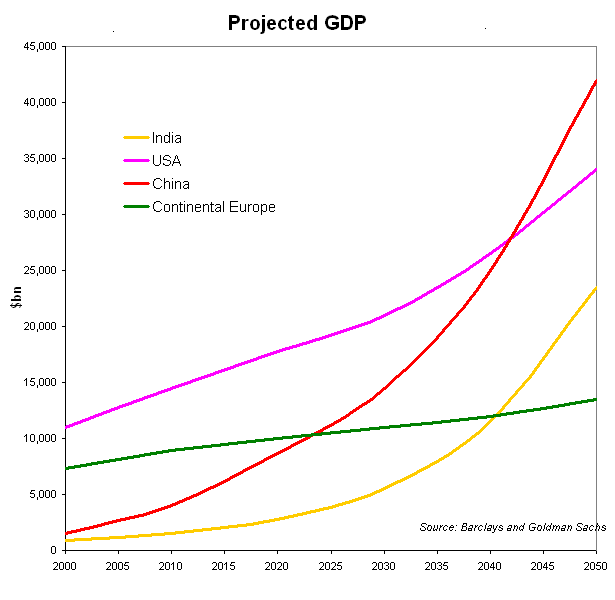14: Projected GDP Growth – what impact does this have on your investments?
08-31-2004
PropertyInvesting.Net
We have previously made the point that trends are particularly important when deciding where to invest in property. Capital values and rental income will often follow economic fundamentals. Ultimately, the more we produce and earn, the higher the capital property values are likely to be. Property values tend to mirror GDP with a strong overprint of supply and demand. The supply might be constrained by lack of land, lack of building. Demand might be stimulated by more people moving into the area and rapid economic growth.
We have already done an analysis of the demographic trends that are important to follow. What we can now provide you is a chart showing the projected GDP for USA, China, India and Continental Europe (source data from Barclays and Goldman Sachs).
What the chart shows is the tremendous increase in GDP in both China and India – China GDP increases ten fold in the next 20 years. India follows suit and really kicks in after 2020. Both have growth rates in the 5-10% per annum range.

The USA also has fairly healthy GDP growth, in part because of its increasing population, as I have outline in my population trends analysis. Continental Europe has a fairly miserable projected GDP growth – because of low economic growth, very low population growth (some countries will have declining populations such as Italy) and a large retired population.
So what does all this mean for property investing? A few key insights are:
USA: The GDP growth in the USA is likely to support capital values of real estate – along with the healthy population growth. Areas with large amounts of building land with less planning restrictions will likely have prices in the doldrums (e.g. Dakota). However, areas where the population is increasing and planning restrictions are intense should see further price increases (e.g. coastal Florida, Atlantic coast, many parts around New York, California – particularly on the coast).
India: In urban areas that have important business and commercial centres, real estate prices will likely skyrocket, particularly in central districts. Select coastal locations (resorts) should also do very well from wealthy Indian retiring and second holiday home owners. Many Indians tend to retire back to their family towns, villages or cities – so there will also be a general increase in practically all property prices. The Goa area stands out as a potentially good investment area, as does Bangalore – the centre for IT and call centres.
China: Similar to India – in urban areas with important business and commercial centres, real estate prices will likely skyrocket, particularly in central districts. Select coastal locations, in south coast resort areas, should also do very well as wealthy Chinese retire or purchase holiday homes. The Chinese prefer to retire close to their family – this should support a widespread increase in prices, particularly in more heavily populated areas. Shanghai stands out – since it is the premier business centre in China. Beijing, the centre for Government will also likely do very well.
Continental Europe: Prices in inland suburban areas, particularly those reliant on manufacturing and heavier industries are likely to be depressed. Examples include industrial parts of north and eastern Germany and the Ruhr area. Picturesque areas that make good retirement centres will do far better – example include the south coast of France, south coast of Spain, Alpine areas in Germany, Czech Republic and Austria and southern coastal areas in the UK. Major city centres reliant on service and finance such as central London, Munich, Madrid and Paris will also likely do okay.
What does this mean for your investment planning?
For the serious investor, who likes to think outside the box, it is time to start thinking about property investments in China and India as part of a large portfolio. European investors need to be cautious about the long term – a safer bet is to make sure you are properly exposure in areas that will be popular for active retiring baby-boomers. This is also probably a good option for the USA. For further details on demographics, review my section on trends. I hope this article has been helpful to you, in providing some insights into longer term economic trends for your investment decisions. If you wish to contact me about this analysis, please email me on enquiries@propertyinvesting.net
back to top

